Module 10 On the radio Unit 2 It seemed that they were speaking to me in person 课件(共17张PPT)
文档属性
| 名称 | Module 10 On the radio Unit 2 It seemed that they were speaking to me in person 课件(共17张PPT) | 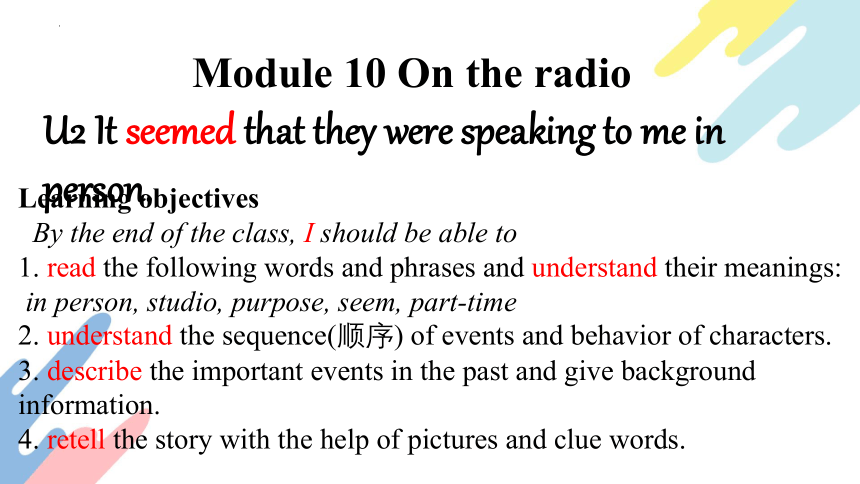 | |
| 格式 | pptx | ||
| 文件大小 | 5.7MB | ||
| 资源类型 | 教案 | ||
| 版本资源 | 外研版 | ||
| 科目 | 英语 | ||
| 更新时间 | 2022-05-17 06:40:42 | ||
图片预览

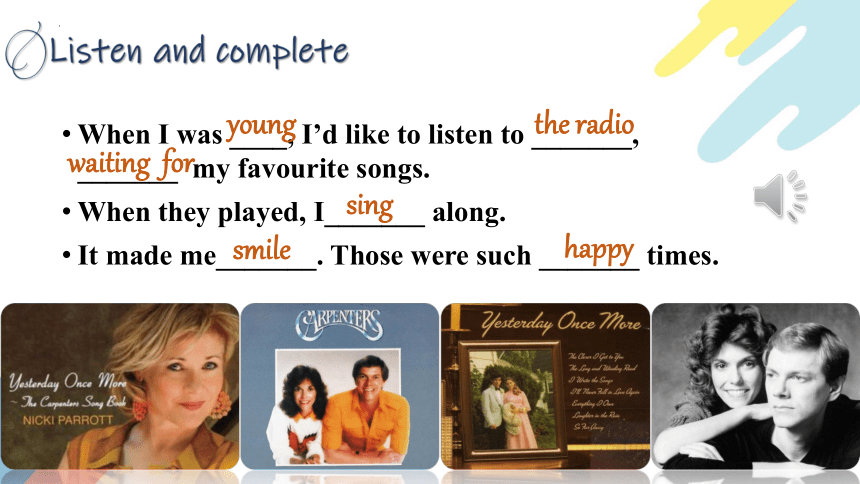
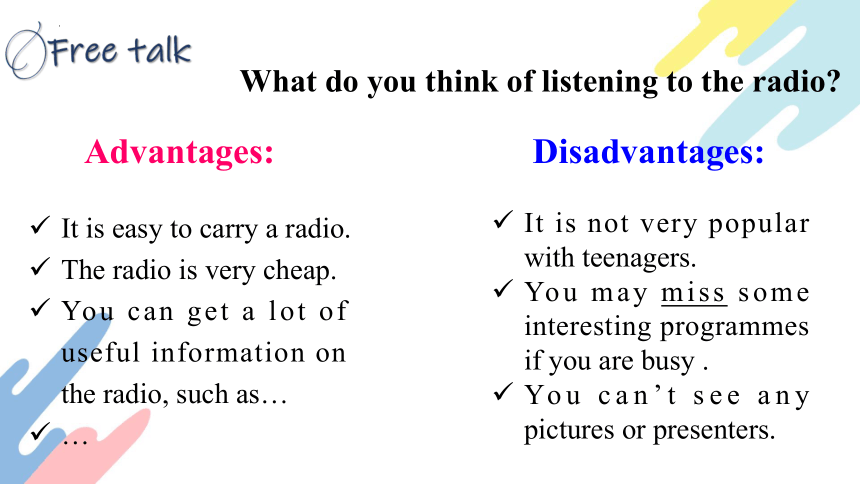
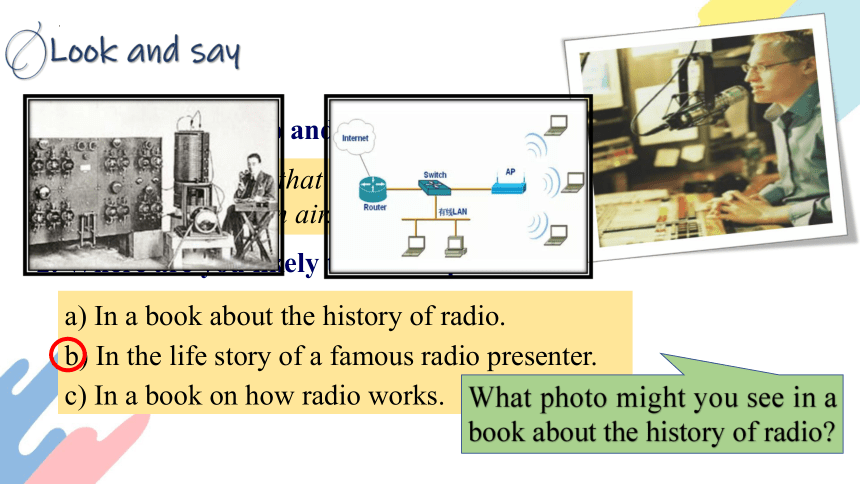
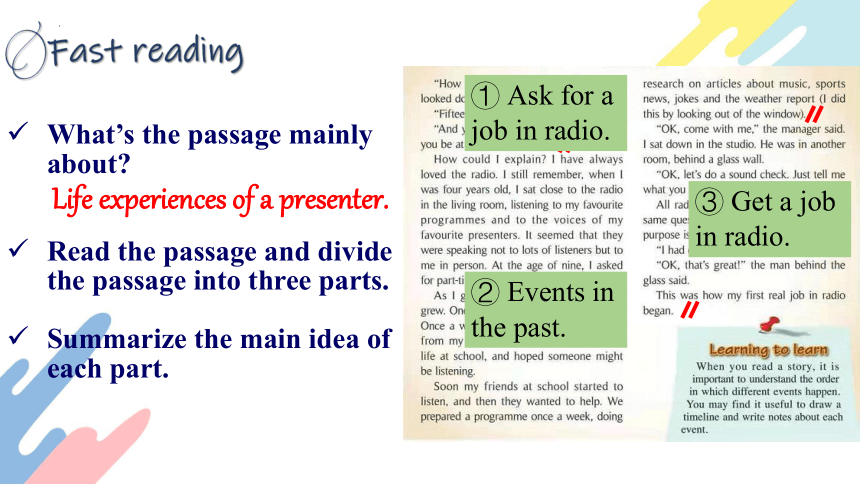
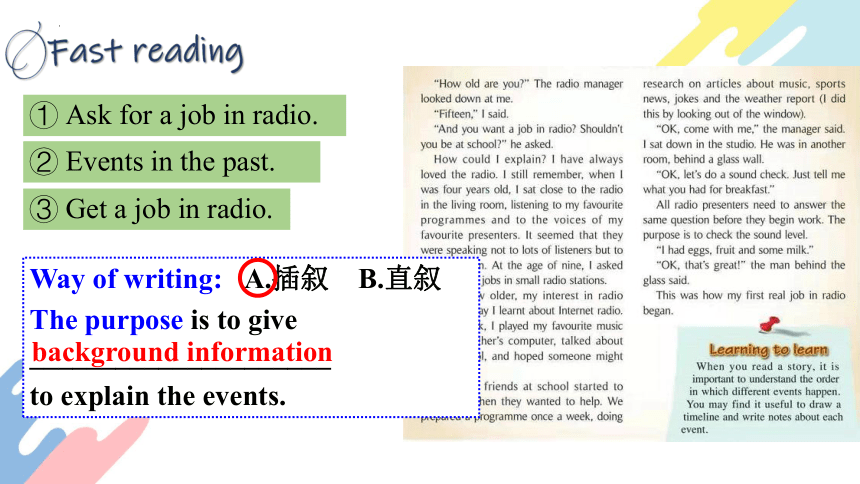
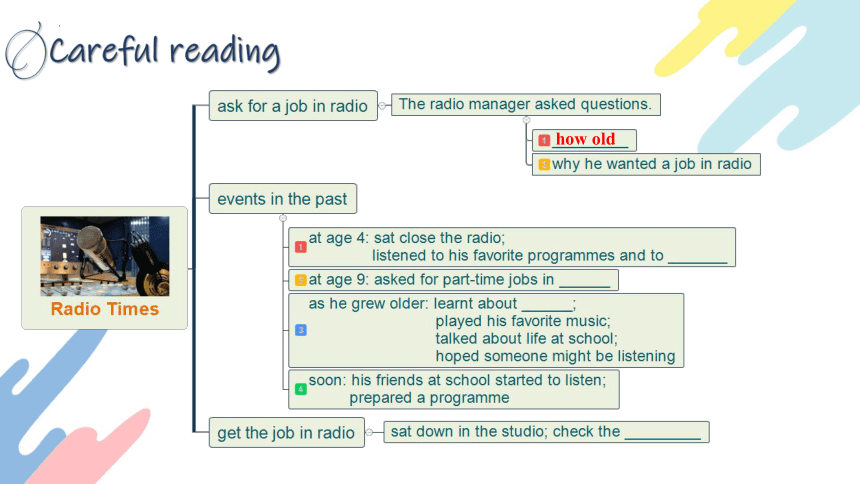
文档简介
(共17张PPT)
Module 10 On the radio
U2 It seemed that they were speaking to me in person.
Learning objectives
By the end of the class, I should be able to
1. read the following words and phrases and understand their meanings:
in person, studio, purpose, seem, part-time
2. understand the sequence(顺序) of events and behavior of characters.
3. describe the important events in the past and give background information.
4. retell the story with the help of pictures and clue words.
Listen and complete
When I was ____, I’d like to listen to _______, _______ my favourite songs.
When they played, I_______ along.
It made me_______. Those were such _______ times.
young
the radio
waiting for
sing
smile
happy
What do you think of listening to the radio
Advantages:
Disadvantages:
It is easy to carry a radio.
The radio is very cheap.
You can get a lot of useful information on the radio, such as…
…
It is not very popular with teenagers.
You may miss some interesting programmes if you are busy .
You can’t see any pictures or presenters.
Free talk
1. Look at the photo and say what it shows.
It probably shows that a newsreader or a presenter is on air.
Look and say
2. Where are you likely to see the photo
a) In a book about the history of radio.
b) In the life story of a famous radio presenter.
c) In a book on how radio works.
What photo might you see in a book about the history of radio
Fast reading
What’s the passage mainly about
Read the passage and divide the passage into three parts.
Summarize the main idea of each part.
Life experiences of a presenter.
① Ask for a job in radio.
② Events in the past.
③ Get a job in radio.
① Ask for a job in radio.
② Events in the past.
③ Get a job in radio.
Way of writing: A.插叙 B.直叙
The purpose is to give _____________________
to explain the events.
background information
Fast reading
Careful reading
how old
Careful reading
to the voice of his favorite presenters
a small radio station
Internet radio
someone might be listening
Tip 1: When you read a story, it is important to understand the order in which different events happen. You may find it useful to draw a timeline and write notes about each event.
Careful reading
Important events in the past Background information
One day I learnt about Internet radio.
Once a week. I played my favourite music from my father’s computer, talked about life at school, and hoped someone might be listening.
Soon my friends at school started to listen, and then they wanted to help.
We prepared a programme once a week, doing research on articles about music, sports news, jokes and the weather report (I did this by looking out of the window).
Tip 2: When you write a story, it is important to use background information to support an important event.
To make the events vivid and concrete.
Careful reading
sound level
What can we infer from the last part
The writer is not very familiar with the procedure(步骤) of the test.
The writer had a great number of experience as a presenter.
The manager was interested in what the writer had for breakfast.
The manager was satisfied with the writer’s sound level.
Critical reading
What is the narrative style of this article
A. Interjection(插叙) B. Direct narration(直叙)
2. Why does the writer choose this kind of style
To give _____________________to explain the events.
To make the article ____________________________.
3. What do you think of the writer And why
determined brave gifted skillful clever ________
background information
vivid, concrete and full of changes
Post reading
article, at the age of, in person, listener, purpose, seem, studio
Peter (1) _____ to be very happy with his new job. He works in the (2) _______ of a local radio station. He is lucky that (3) _____________ only twenty he is doing something he loves and has a real (4) _________. Every morning when he starts work, he does a sound check and then he looks for interesting newspaper (5) ______ to talk about on the show. The (6) _______ can phone in to talk to Peter or they can send emails to ask him to play their favorite songs. At the end of the show, he closes down all the equipment and goes home.
seems
studio
at the age of
purpose
articles
listeners
Post reading
Soon my friends…started to…and then wanted …
We prepared…
once a week
We also did …for…I did this by
We did … by… about…
One day…
learn…Internet radio.
Once a week…played … from…
Group work
News type: sports news
Presenter A: _______. I’m Tony.
Presenter B: I’m Betty. Today is Ruixiang Middle School Open Day. Many visitors are coming here. Now let’s go over to Lingling for the latest report. Hi, Lingling, can you tell us what happens there now
Reporter C: OK. There are lots of visitors here. Some parents even take their little children here. They walk into the classroom to have class or look around the campus. That’s all. Back to you, Betty.
Presenter B: Thank you. Wish everyone here could have a nice day.
Presenter A: _______. Today there is a football match between Class One and Class Four. _______. Hi, Kitty, _______
Reporter D: Yes, at the moment, Class One is 1, Class Four is 2. But there is still 30 seconds left. We don’t know who is the winner. Oh, my god. Class Four beat Class One. I am so excited now. _______.
Presenter A: Thank you, Kitty. _______
A. Now let’s go over to Kitty for the latest report.
B. Thank you. That’s all. Back to you, Tony.
C. That’s the end of the ten o’clock news! See you tomorrow.
D. Good morning, everyone. This is Ruixiang Middle School news.
E. Today it’s June 10th, Monday. Now it’s 10 o’ clock.
F. can you tell us the score now
D
E
A
F
B
C
Group work
News type: sports news
Presenter A: Good morning, everyone. This is Ruixiang Middle School news. I’m **.
Presenter B: I’m **. ___________________________________. Hi, **, can you tell us what happens there now
Reporter C: OK. ______________. That’s all. Back to you, **.
Presenter B: Thank you. _______________.
Presenter A: Today it’s _________________________. Now let’s go over to ** for the latest report. Hi, Kitty, _______.
Reporter D: _________________________. Thank you. That’s all. Back to you, **.
Presenter A: Thank you, **. That’s the end of the ten o’clock news! See you tomorrow.
Module 10 On the radio
U2 It seemed that they were speaking to me in person.
Learning objectives
By the end of the class, I should be able to
1. read the following words and phrases and understand their meanings:
in person, studio, purpose, seem, part-time
2. understand the sequence(顺序) of events and behavior of characters.
3. describe the important events in the past and give background information.
4. retell the story with the help of pictures and clue words.
Listen and complete
When I was ____, I’d like to listen to _______, _______ my favourite songs.
When they played, I_______ along.
It made me_______. Those were such _______ times.
young
the radio
waiting for
sing
smile
happy
What do you think of listening to the radio
Advantages:
Disadvantages:
It is easy to carry a radio.
The radio is very cheap.
You can get a lot of useful information on the radio, such as…
…
It is not very popular with teenagers.
You may miss some interesting programmes if you are busy .
You can’t see any pictures or presenters.
Free talk
1. Look at the photo and say what it shows.
It probably shows that a newsreader or a presenter is on air.
Look and say
2. Where are you likely to see the photo
a) In a book about the history of radio.
b) In the life story of a famous radio presenter.
c) In a book on how radio works.
What photo might you see in a book about the history of radio
Fast reading
What’s the passage mainly about
Read the passage and divide the passage into three parts.
Summarize the main idea of each part.
Life experiences of a presenter.
① Ask for a job in radio.
② Events in the past.
③ Get a job in radio.
① Ask for a job in radio.
② Events in the past.
③ Get a job in radio.
Way of writing: A.插叙 B.直叙
The purpose is to give _____________________
to explain the events.
background information
Fast reading
Careful reading
how old
Careful reading
to the voice of his favorite presenters
a small radio station
Internet radio
someone might be listening
Tip 1: When you read a story, it is important to understand the order in which different events happen. You may find it useful to draw a timeline and write notes about each event.
Careful reading
Important events in the past Background information
One day I learnt about Internet radio.
Once a week. I played my favourite music from my father’s computer, talked about life at school, and hoped someone might be listening.
Soon my friends at school started to listen, and then they wanted to help.
We prepared a programme once a week, doing research on articles about music, sports news, jokes and the weather report (I did this by looking out of the window).
Tip 2: When you write a story, it is important to use background information to support an important event.
To make the events vivid and concrete.
Careful reading
sound level
What can we infer from the last part
The writer is not very familiar with the procedure(步骤) of the test.
The writer had a great number of experience as a presenter.
The manager was interested in what the writer had for breakfast.
The manager was satisfied with the writer’s sound level.
Critical reading
What is the narrative style of this article
A. Interjection(插叙) B. Direct narration(直叙)
2. Why does the writer choose this kind of style
To give _____________________to explain the events.
To make the article ____________________________.
3. What do you think of the writer And why
determined brave gifted skillful clever ________
background information
vivid, concrete and full of changes
Post reading
article, at the age of, in person, listener, purpose, seem, studio
Peter (1) _____ to be very happy with his new job. He works in the (2) _______ of a local radio station. He is lucky that (3) _____________ only twenty he is doing something he loves and has a real (4) _________. Every morning when he starts work, he does a sound check and then he looks for interesting newspaper (5) ______ to talk about on the show. The (6) _______ can phone in to talk to Peter or they can send emails to ask him to play their favorite songs. At the end of the show, he closes down all the equipment and goes home.
seems
studio
at the age of
purpose
articles
listeners
Post reading
Soon my friends…started to…and then wanted …
We prepared…
once a week
We also did …for…I did this by
We did … by… about…
One day…
learn…Internet radio.
Once a week…played … from…
Group work
News type: sports news
Presenter A: _______. I’m Tony.
Presenter B: I’m Betty. Today is Ruixiang Middle School Open Day. Many visitors are coming here. Now let’s go over to Lingling for the latest report. Hi, Lingling, can you tell us what happens there now
Reporter C: OK. There are lots of visitors here. Some parents even take their little children here. They walk into the classroom to have class or look around the campus. That’s all. Back to you, Betty.
Presenter B: Thank you. Wish everyone here could have a nice day.
Presenter A: _______. Today there is a football match between Class One and Class Four. _______. Hi, Kitty, _______
Reporter D: Yes, at the moment, Class One is 1, Class Four is 2. But there is still 30 seconds left. We don’t know who is the winner. Oh, my god. Class Four beat Class One. I am so excited now. _______.
Presenter A: Thank you, Kitty. _______
A. Now let’s go over to Kitty for the latest report.
B. Thank you. That’s all. Back to you, Tony.
C. That’s the end of the ten o’clock news! See you tomorrow.
D. Good morning, everyone. This is Ruixiang Middle School news.
E. Today it’s June 10th, Monday. Now it’s 10 o’ clock.
F. can you tell us the score now
D
E
A
F
B
C
Group work
News type: sports news
Presenter A: Good morning, everyone. This is Ruixiang Middle School news. I’m **.
Presenter B: I’m **. ___________________________________. Hi, **, can you tell us what happens there now
Reporter C: OK. ______________. That’s all. Back to you, **.
Presenter B: Thank you. _______________.
Presenter A: Today it’s _________________________. Now let’s go over to ** for the latest report. Hi, Kitty, _______.
Reporter D: _________________________. Thank you. That’s all. Back to you, **.
Presenter A: Thank you, **. That’s the end of the ten o’clock news! See you tomorrow.
同课章节目录
- Module 1 Feelings and impressions
- Unit 1 It smells delicious.
- Unit 2 I feel nervous when I speak Chinese .
- Unit 3 Language in use
- Module 2 Experiences
- Unit 1 I've also entered lots of speaking competi
- Unit 2 They have seen the Pyramids.
- Unit 3 Language in use
- Module 3 Journey to space
- Unit 1 Has it arrived yet?
- Unit 2 We have not found life on any other planet
- Unit 3 Language in use
- Module 4 Seeing the docto
- Unit 1 I haven't done much exercise since I got m
- Unit 2 We have played football for a year now
- Unit 3 Language in use
- Module 5 Cartoons
- Unit 1 It's time to watch a cartoon.
- Unit 2 Tintin has been popular for over eighty yea
- Unit 3 Language in use
- Revision module A
- Module 6 Hobbies
- Unit 1 Do you collect anything ?
- Unit 2 Hobbies can make you grow as a person.
- Unit 3 Language in use
- Module 7 Summer in Los Angeles
- Unit 1 Please write to me and send me some photos
- Unit 2 Fill out a form and come to learn English
- Unit 3 Language in use
- Module 8 Time off
- Unit 1 I can hardly believe we are in the city ce
- Unit 2 We thought somebody was moving about
- Unit 3 Language in use
- Module 9 Friendship
- Unit 1 Could I ask if you've mentioned this to he
- Unit 2 I believe that the world is what you think
- Unit 3 Language in use
- Module 10 On the radio
- Unit 1 I hope that you can join us one day
- Unit 2 It seemed that they were speaking to me in
- Unit 3 Language in use
- Revision module B
